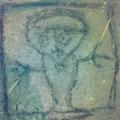DMT-Nexus member
Posts: 6 Joined: 03-Apr-2011 Last visit: 28-Jul-2011 Location: Somewhere
|
Alright so i did a calculation and figured 40g NaOH in 2500mL of water would give me a pH of 13.6. But i think i may have done it wrong since i usually hear others using a lot higher of a base/water ratio than that. Can someone help me with my confusion?? lol Thanks
|
|
|
|
|

DMT-Nexus member

Posts: 14191 Joined: 19-Feb-2008 Last visit: 22-Nov-2025 Location: Jungle
|
Just add NaOH till the mimosa solution is completely black,and a little bit more just for good measure. Thats the neat thing about it, its as if the solution itself is a pH meter with neat color changes. Dont shake when mixing solvent, rather stir/move container in round motions to stir. If by any chance the layers dont separate well, you can add more NaOH but once its black it should be enough.
|
|
|
DMT-Nexus member
Posts: 6 Joined: 03-Apr-2011 Last visit: 28-Jul-2011 Location: Somewhere
|
Yea the first extraction is already done, 250g NaOH and 2500mL water, there surely wasnt a problem with getting the pH high enough since the jar got soo hot i thought it was about to burst. haha It did turn a very blackish color just as you said too, the extraction went well. I was just wondering if 250g was a bit over-load, if necessary pH levels could be reached using much less base.
|
|
|

DMT-Nexus member

Posts: 14191 Joined: 19-Feb-2008 Last visit: 22-Nov-2025 Location: Jungle
|
The pH wont only be a function of water and NaOH but also amount of mimosa, since mimosa is acidic therefore part of the NaOH will first neutralize the acid and then will make the pH basic. I dont remember exactly the amount of NaOH to turn black a solution of X grams of water and Y volume of water. 250g does seem like a lot of lye and my guess is you would probably need less, but yeah just go by color and you should be fine 
|
|
|

Oz
Posts: 144 Joined: 01-Jun-2010 Last visit: 27-Apr-2011 Location: Oz
|
i asked about this before and was told by most to stick to the 1:1. noone gave me a real answer why. its obvious it doesnt take 50g lye to make 50g bark in 500 or 1000ml of water 14 but i believe the excess helps with separation yet is that just a property of ph or does it have to do with TDS or amount of dissolved salts. noone could say why.
benzyme/other real chemists, please chime in with why what amount of lye is needed. it would be a good sticky thread in science forum. a short explanation of howmuch and why, then we can work a simple formula to tell u how much you need to replace the old 1M:1L:15W ratio.
|
|
|
DMT-Nexus member
Posts: 176 Joined: 23-Jun-2010 Last visit: 07-Nov-2025
|
letgogetlost wrote:Yea the first extraction is already done, 250g NaOH and 2500mL water, there surely wasnt a problem with getting the pH high enough since the jar got soo hot i thought it was about to burst. This can be countered by adding your lye slowly, in increments, while making sure all lye is completely dissolved and jar has cooled down a bit before adding more. An overly hot jar cracking and/or bursting will send extremely caustic water to go everywhere as you could imagine. Some people mix solutions in jars that are sitting inside large pots to catch and potential breakage of glass.
|
|
|
DMT-Nexus member
Posts: 6 Joined: 03-Apr-2011 Last visit: 28-Jul-2011 Location: Somewhere
|
Red Eclipse wrote:letgogetlost wrote:Yea the first extraction is already done, 250g NaOH and 2500mL water, there surely wasnt a problem with getting the pH high enough since the jar got soo hot i thought it was about to burst. This can be countered by adding your lye slowly, in increments, while making sure all lye is completely dissolved and jar has cooled down a bit before adding more. An overly hot jar cracking and/or bursting will send extremely caustic water to go everywhere as you could imagine. Some people mix solutions in jars that are sitting inside large pots to catch and potential breakage of glass. yeahh thats the one thing i forgot to do.. i added the lye prettly slowly but forgot to stir it and alot of it clumped up at the bottom. but it was fixed and turned out ok, gonna make sure not to make that mistake again, it coulda been a real mess
|
|
|
DMT-Nexus member
Posts: 6 Joined: 03-Apr-2011 Last visit: 28-Jul-2011 Location: Somewhere
|
now i see how my pH would be somewhat off...i didnt know and didnt take into account that them mimosa is slightly acidic, that would do it.lol if someone could chime in with an explanation that would be awesome, it would be nice to know just for curiosity's sake. im assuming it would be pretty complex to get the exact pH with the addition of mimosa, needing to know its Ka value or sumthin... 
|
|
|

Stiletto Stoner

Posts: 1132 Joined: 18-Nov-2008 Last visit: 15-Mar-2015 Location: Blazin'
|
LandOfOz wrote:i asked about this before and was told by most to stick to the 1:1. noone gave me a real answer why. its obvious it doesnt take 50g lye to make 50g bark in 500 or 1000ml of water 14 but i believe the excess helps with separation yet is that just a property of ph or does it have to do with TDS or amount of dissolved salts. noone could say why.
benzyme/other real chemists, please chime in with why what amount of lye is needed. it would be a good sticky thread in science forum. a short explanation of howmuch and why, then we can work a simple formula to tell u how much you need to replace the old 1M:1L:15W ratio. I was there too, LandOfOz  pH is a lot more complicated than it seems at first. Type of acids, "power" of acids, "type" of water, etc. From my experince with playing around and calculating pH, theory always differs from the pH meter so I don't think a "formula" would help. Needed pH levels also vary on the method used and the solvents. Got GVG ? Mhm. Got DMT ? Pandora wrote:Nexus enjoys cutting edge and ongoing superior programming skills of the owner of this site (The Traveler), including recent switching to the .me domain name. I'm still, I'm still Jenny from the block Simon Jester wrote:"WTF n00b, buy the $100 vapor pipe or GTFO" Ignorance of the law does not protect you from prosecution
|
|
|

Kalt und Heiß, Schwarz und Rot, Kürper und Geist, Liebe und Chaos
 
Posts: 4661 Joined: 02-Jun-2008 Last visit: 30-Apr-2022
|
LandOfOz wrote:i asked about this before and was told by most to stick to the 1:1. noone gave me a real answer why. its obvious it doesnt take 50g lye to make 50g bark in 500 or 1000ml of water 14 but i believe the excess helps with separation yet is that just a property of ph or does it have to do with TDS or amount of dissolved salts. noone could say why. Actually 40g of lye in 1000ml of (pure, distilled, unbuffered) water is exactly what you need to reach a pH of 14. The extra 10g in the example you set are there to neutralise acids naturally found in MHRB as well as to overcome any buffering barriers of the mhrb soup (changing the pH of a plant extract can be far more difficult than changing the pH of just water). Re your questions, the amount of lye you need is the one that will reach you at a pH of 13+. This is the closest to a reasonable answer you'll get. Given that pH values of 13+ are difficult to measure correctly with the cheap inaccurate pH meters of home extractors, it makes little sense to try to find the minimum amount of lye needed per bark per ml to reach an STB-acceptable pH. Instead of bothering with these technicalities, the 1:1:15 ratio is convenient because it is foolproof. Many people often have problems with underbasification as well as emulsions. The lye overload helps with both problems and people are happy. Too much lye increases the ionic strength of the solution and helps tremendously with layer separation as you already mention and it most certainly raises the pH to above 13 without a shadow of doubt. Finally, if that's of any interest, SWIM' done STBs with half the amount of lye (i.e. 1:0.5:15) and things went according to the book. Need to calculate between salts and freebases? Click here! Need to calculate freebase or salt percentage at a given pH? Click here!
|